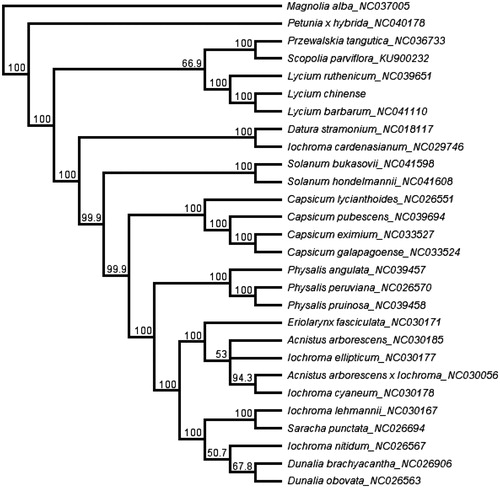Abstract
Lycium chinense is an important edible and medicinal plant. Now, the complete chloroplast (cp) genome of L. chinense was assembled based on the Illumina sequencing reads. The cp genome of L. chinense was 155,736 bp long and contained two short inverted repeat regions (25,469 bp), which were separated by a small single-copy region (18,206 bp) and a large single-copy region (86,592 bp). The cp genome encodes 113 unique genes, including 79 protein-coding genes, 30 transfer RNA genes, and 4 ribosomal RNA genes. The topology of the phylogenetic tree showed that L. chinense is closely clustered with species Lycium ruthenicum and Lycium barbarum.
The genus Lycium contains several well-known medicinal and food plants in Solanaceae, such as Lycium barbarum, Lycium chinense, and Lycium ruthenicum. There are about 80 Lycium species around the world (Miller Citation2002; Levin and Miller Citation2005). Lycium chinense is food and herbal medicine in China and plays an important role in Chinese traditional medicine and has been used for thousands of years (Olivier Citation2009). The fruits of L. chinense have potential pharmacological effects such as anti-aging, reducing blood glucose and serum lipids, immune regulation, among others (Qin et al. Citation2001). In order to clarify the taxonomical position of L. chinense in Rosaceae, we applied the Illumina technology to sequence, assemble and annotate the whole chloroplast (cp) genome of L. chinense. The resultant data have been made publicly available as a resource for genetic information for Lycium species, and will provide a valuable plastid genomic resource for the future genetic and phylogenetic studies about L. chinense.
The fresh leaves of L. chinense were collected from the field of Kunming (25.20°N, 102.86°E). The voucher specimen was deposited at Herbarium of Yunnan Agricultural University (No. 2019HSL003). Total genomic DNA was isolated from fresh leaves using a DNeasy Plant Mini Kit (QIAGEN, Valencia, California, USA) according to the manufacturer’s instructions to construction cp DNA libraries. The Illumina sequencing was conducted by Biomarker Technologies Inc. (Beijing, China). Resultant clean reads were assembled using GetOrganelle pipeline (https://github.com/Kinggerm/GetOrganelle). The genome was automatically annotated by using the CpGAVAS pipeline (Liu et al. Citation2012) and start/stop codons and intron/exon boundaries were adjusted in Geneious R11.0.2 (Biomatters Ltd., Auckland, New Zealand). All the contigs were checked against the reference genome of L. ruthenicum (NC039651).
The complete cp genome of L. chinense was 159,898 bp in length (Genbank accession number: MN102357). It was the typical quadripartite structure and contained two short inverted repeat regions(IRa and IRb) of 26,540 bp each, which were separated by a small single-copy (SSC) region (19,219 bp) and a large single-copy (LSC) region (87,599 bp). The cp genome encodes 109 unique genes, including 75 protein-coding genes, 30 transfer RNA (tRNA) genes and 4 ribosomal RNA (rRNA) genes. Twenty gene species are partially or completely duplicated, including nine PCG (ndhB, rpl2, rpsl23, rps12, rps19, rps7, ycf1, ycf2, and ycf15), seven tRNA (trnI-GAU, trnA-UGC, trnL-CAA, trnI-CAU, trnR-ACG, trnV-GAC, and trnN-GUU), and all four rRNA (4.5S, 5S, 16S, and 23S rRNA). The overall GC content of the cp genome was 37.8%, while that of LSC, SSC, and IR regions was 35.9, 32.3, and 43.1%, respectively.
A total of 28 cp genome sequences were selected to infer the phylogenetic relationships among the main representative species of Solanaceae with Magnolia alba (NC037005, Magnoliaceae) as the outgroup. The combined datasets based on plastid genomes were aligned by MAFFT v7.307 (Katoh and Standley Citation2013). A neighbour-joining (NJ) phylogenetic tree was constructed in Geneious 11.1.5 (Kearse et al. Citation2012) with the Tamura–Nei genetic distance model, and a total of 1000 bootstrap replicates were performed. The topology of the phylogenetic tree showed that L. chinense has a close relationship with species L. ruthenicum and L. barbarum (). The complete cp genome information reported in this study will be a valuable resource for future studies on genetic diversity, taxonomy, and phylogeny of the Solanaceae.
Disclosure statement
No potential conflict of interest was reported by the authors.
Additional information
Funding
References
- Katoh K, Standley DM. 2013. MAFFT multiple sequence alignment software version 7: improvements in performance and usability. Mol Biol Evol. 30(4):772.
- Kearse M, Moir R, Wilson A, Stones-Havas S, Cheung M, Sturrock S, Buxton S, Cooper A, Markowitz S, Duran C, et al. 2012. Geneious Basic: an integrated and extendable desktop software platform for the organization and analysis of sequence data. Bioinformatics. 28(12):1647.
- Levin RA, Miller JS. 2005. Relationships within tribe Lycieae (Solanaceae): paraphyly of Lycium and multiple origins of gender dimorphism. Am J Bot. 92(12):2044–2053.
- Liu C, Shi L, Zhu Y, Chen H, Zhang J, Lin X, Guan X. 2012. CpGAVAS, an integrated web server for the annotation, visualization, analysis, and GenBank submission of completely sequenced chloroplast genome sequences. BMC Genomics. 13(1):715.
- Miller JS. 2002. Phylogenetic relationships and the evolution of gender dimorphism in Lycium (Solanaceae). Syst Bot. 27:416–428.
- Olivier P. 2009. Goji (Lycium barbarum and L. chinense): phytochemistry, pharmacology and safety in the perspective of traditional uses and recent popularity. Planta Med. 76:7–19.
- Qin X, Yamauchi R, Aizawa K, Inakuma T, Kato K. 2001. Structural features of arabinogalactan–proteins from the fruit of Lycium chinense Mill. Carbohydr Res. 333(1):79–85.

